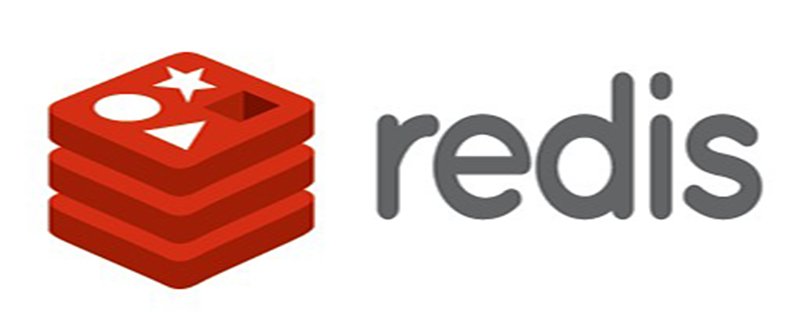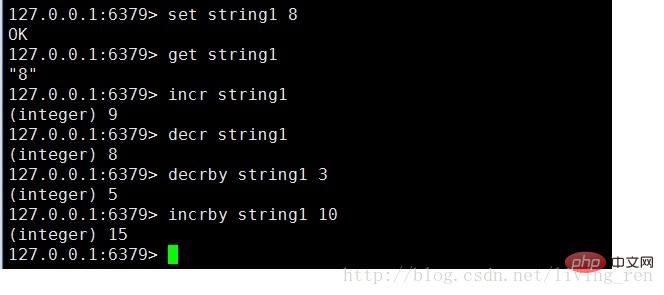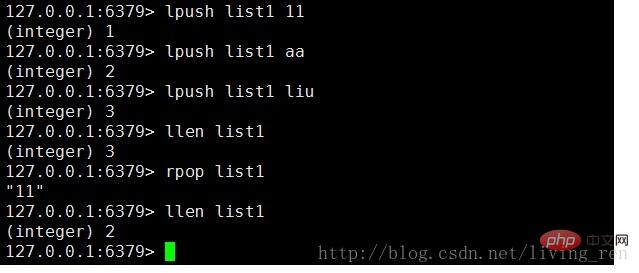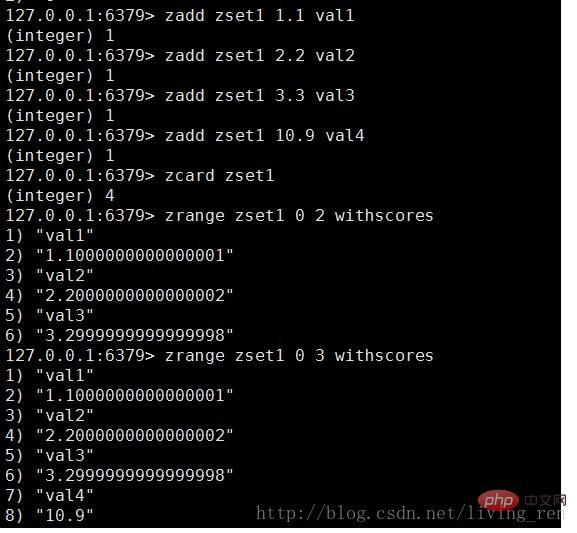Take a look at the 5 data types of redis

1. 5 data types of redis:
string string (can be integer, floating point and string, collectively called elements)
list list (implementation Queue, elements are not unique, first-in-first-out principle)
set set (different elements)
hash hash value (hash key must be unique)
sort set ordered set
Recommended (free): redis tutorial
2. Common commands for string type:
Self-increment: incr
Self-decrement: decr
Add: incrby
Subtract: decrby 
3. Common commands supported by list type:
lpush: push from the left
lpop: pop from the right
rpush: Push from the right
rpop: Pop from the right
llen: Check the length of a list data type 
4. Common commands supported by the set type:
sadd: Add data
scard: Check the number of elements existing in the set data
sismember: Determine whether an element exists in the set data
srem: Delete an element in a set data
5. Common commands supported by hash data type:
hset: Add hash data
hget: Get hash data
hmget: Get multiple hash data 
6 , sort set is very similar to hash, and is also a mapping form of storage:
zadd: add
zcard: query
zrange: data sorting 
The above is the detailed content of Take a look at the 5 data types of redis. For more information, please follow other related articles on the PHP Chinese website!

Hot AI Tools

Undresser.AI Undress
AI-powered app for creating realistic nude photos

AI Clothes Remover
Online AI tool for removing clothes from photos.

Undress AI Tool
Undress images for free

Clothoff.io
AI clothes remover

Video Face Swap
Swap faces in any video effortlessly with our completely free AI face swap tool!

Hot Article

Hot Tools

Notepad++7.3.1
Easy-to-use and free code editor

SublimeText3 Chinese version
Chinese version, very easy to use

Zend Studio 13.0.1
Powerful PHP integrated development environment

Dreamweaver CS6
Visual web development tools

SublimeText3 Mac version
God-level code editing software (SublimeText3)

Hot Topics
 1676
1676
 14
14
 1429
1429
 52
52
 1333
1333
 25
25
 1278
1278
 29
29
 1257
1257
 24
24
 Is Redis a SQL or NoSQL Database? The Answer Explained
Apr 18, 2025 am 12:11 AM
Is Redis a SQL or NoSQL Database? The Answer Explained
Apr 18, 2025 am 12:11 AM
RedisisclassifiedasaNoSQLdatabasebecauseitusesakey-valuedatamodelinsteadofthetraditionalrelationaldatabasemodel.Itoffersspeedandflexibility,makingitidealforreal-timeapplicationsandcaching,butitmaynotbesuitableforscenariosrequiringstrictdataintegrityo
 Redis's Role: Exploring the Data Storage and Management Capabilities
Apr 22, 2025 am 12:10 AM
Redis's Role: Exploring the Data Storage and Management Capabilities
Apr 22, 2025 am 12:10 AM
Redis plays a key role in data storage and management, and has become the core of modern applications through its multiple data structures and persistence mechanisms. 1) Redis supports data structures such as strings, lists, collections, ordered collections and hash tables, and is suitable for cache and complex business logic. 2) Through two persistence methods, RDB and AOF, Redis ensures reliable storage and rapid recovery of data.
 Redis: Understanding Its Architecture and Purpose
Apr 26, 2025 am 12:11 AM
Redis: Understanding Its Architecture and Purpose
Apr 26, 2025 am 12:11 AM
Redis is a memory data structure storage system, mainly used as a database, cache and message broker. Its core features include single-threaded model, I/O multiplexing, persistence mechanism, replication and clustering functions. Redis is commonly used in practical applications for caching, session storage, and message queues. It can significantly improve its performance by selecting the right data structure, using pipelines and transactions, and monitoring and tuning.
 Redis: Classifying Its Database Approach
Apr 15, 2025 am 12:06 AM
Redis: Classifying Its Database Approach
Apr 15, 2025 am 12:06 AM
Redis's database methods include in-memory databases and key-value storage. 1) Redis stores data in memory, and reads and writes fast. 2) It uses key-value pairs to store data, supports complex data structures such as lists, collections, hash tables and ordered collections, suitable for caches and NoSQL databases.
 Redis: How It Acts as a Data Store and Service
Apr 24, 2025 am 12:08 AM
Redis: How It Acts as a Data Store and Service
Apr 24, 2025 am 12:08 AM
Redisactsasbothadatastoreandaservice.1)Asadatastore,itusesin-memorystorageforfastoperations,supportingvariousdatastructureslikekey-valuepairsandsortedsets.2)Asaservice,itprovidesfunctionalitieslikepub/submessagingandLuascriptingforcomplexoperationsan
 Redis: Exploring Its Features and Functionality
Apr 19, 2025 am 12:04 AM
Redis: Exploring Its Features and Functionality
Apr 19, 2025 am 12:04 AM
Redis stands out because of its high speed, versatility and rich data structure. 1) Redis supports data structures such as strings, lists, collections, hashs and ordered collections. 2) It stores data through memory and supports RDB and AOF persistence. 3) Starting from Redis 6.0, multi-threaded I/O operations have been introduced, which has improved performance in high concurrency scenarios.
 Redis: The Advantages of a NoSQL Approach
Apr 27, 2025 am 12:09 AM
Redis: The Advantages of a NoSQL Approach
Apr 27, 2025 am 12:09 AM
Redis is a NoSQL database that provides high performance and flexibility. 1) Store data through key-value pairs, suitable for processing large-scale data and high concurrency. 2) Memory storage and single-threaded models ensure fast read and write and atomicity. 3) Use RDB and AOF mechanisms to persist data, supporting high availability and scale-out.
 Redis: Real-World Use Cases and Examples
Apr 20, 2025 am 12:06 AM
Redis: Real-World Use Cases and Examples
Apr 20, 2025 am 12:06 AM
The applications of Redis in the real world include: 1. As a cache system, accelerate database query, 2. To store the session data of web applications, 3. To implement real-time rankings, 4. To simplify message delivery as a message queue. Redis's versatility and high performance make it shine in these scenarios.




